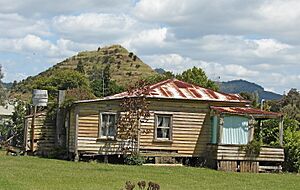Kaeo facts for kids
Quick facts for kids
Kaeo
Kāeo (Māori)
|
|
|---|---|
| Motto(s):
Small town, big spirit
|
|
| Country | New Zealand |
| Region | Northland Region |
| District | Far North District |
| Ward | Bay of Islands-Whangaroa |
| Community | Bay of Islands-Whangaroa |
| Subdivision | Whangaroa |
| Electorates |
|
| Area | |
| • Total | 1.39 km2 (0.54 sq mi) |
| Population
(June 2023)
|
|
| • Total | 260 |
| • Density | 187/km2 (484/sq mi) |
| Postcode |
0478
|
Kaeo (Māori: Kāeo) is a small town in the Far North District of New Zealand. It is located about 22 kilometers (14 miles) northwest of Kerikeri. The town's name comes from the Māori-language name for the New Zealand freshwater mussel. These mussels can be found in the rivers nearby.
A new bridge was opened in February 2024 on State Highway 10 across the Kaeo River. This bridge helps reduce traffic jams and makes the road safer.
Contents
History of Kaeo
Early Māori Life
Kaeo was once a strong, fortified village called a pā. It belonged to the Ngati Uru sub-tribe. This tribe arrived in the Whangaroa Harbour area around 1770–1775. They had moved from the Rawhiti area after a conflict.
European Settlers Arrive
The first Wesleyan Methodist mission in New Zealand was set up in Kaeo in June 1823. Missionaries Samuel Leigh and William White started it. However, the mission was later abandoned in 1827. Today, a special stone monument marks where the mission once stood. It is next to the cemetery on the south side of the Kaeo River.
Dealing with Floods
Kaeo is built on the flat land next to the Kaeo River. Because of this, the town has faced many damaging floods. In 2007, Kaeo experienced three big floods in just a few months. These floods happened in February, March, and July. Water filled homes and shops, and even destroyed the local primary school's swimming pool. The rugby clubrooms were also damaged. People from all over the country helped the club raise money to lift their building higher. This helps protect it from future floods.
More heavy rain in February 2008 caused landslides, power outages, and road closures. Flood protection work was planned for Kaeo. In January 2011, Cyclone Wilma caused more floods, and 70 people had to leave their homes for safety.
Important Buildings
The Kaeo Post Office is an old wooden building. It was built in 1912 in the Edwardian style. This building served many purposes over the years. It closed as a post office in May 1989. After being updated in 2012, it now works as a community center and library.
Marae in Kaeo
A marae is a special meeting place for Māori people. The Kaeo area has several marae that are connected to different iwi (tribes) and hapū (sub-tribes). These places are important for community gatherings and cultural events.
- Waihapa Marae and its meeting house, Te Tai Tokerau, are linked to the Ngāti Kahu ki Whangaroa and Ngāpuhi / Ngāti Kahu ki Whaingaroa hapū. In 2020, the government helped fund upgrades to Waihapa Marae.
- Mangawhero Marae and its meeting house, Te Aroha, are also linked to Ngāti Kahu ki Whangaroa and Ngāpuhi / Ngāti Kahu ki Whaingaroa hapū.
- Waitāruke Marae and its meeting house, Kahukura Ariki, are connected to the Hāhi Katorika hapū.
- Other marae in the wider area include Mangaiti Marae, Mangatōwai Marae, Matangirau Marae, Pupuke Marae, Tahawai Marae, Te Pātūnga Marae, and Whakaari Marae. Each of these is important to its local hapū.
People of Kaeo
Population Details
Kaeo is a rural settlement that covers about 1.39 square kilometers (0.54 square miles). In 2023, the estimated population was 249 people. This means there are about 179 people living in each square kilometer.
The population of Kaeo has been growing:
- 2006: 171 people
- 2013: 180 people
- 2018: 228 people
- 2023: 249 people
In 2023, there were 135 males and 114 females living in 84 homes. The average age was 32.9 years. About 28.9% of the people were under 15 years old.
Ethnic Backgrounds
People in Kaeo come from different backgrounds:
- 50.6% identified as European (Pākehā).
- 73.5% identified as Māori.
- 9.6% identified as Pasifika.
- 1.2% identified as Asian.
Most people (95.2%) speak English. About 19.3% also speak the Māori language.
Work and Income
The median income in Kaeo was $29,400. This is the middle income for people aged 15 and over. About 40.7% of people aged 15 and over worked full-time.
Education in Kaeo
Whangaroa College
Whangaroa College is a school for students in years 7 to 15 (ages 11-18). It has about 140 students. The principal since 2015 is Jack Anderson.
Kaeo School
Kaeo School is a primary school for students in years 1 to 6 (ages 5-10). It has about 101 students. The school first opened in 1877. It became Kaeo District High School in 1941, teaching both primary and secondary students. When Whangaroa College opened in 1969, Kaeo School went back to being just a primary school. The current principal is Paul Barker.



